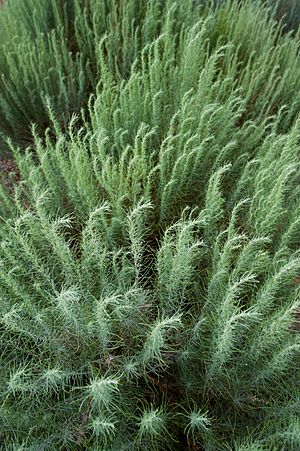Artemisia filifolia facts for kids
Quick facts for kids Artemisia filifolia |
|
|---|---|
 |
|
| Conservation status | |
| Scientific classification | |
| Genus: |
Artemisia
|
| Species: |
filifolia
|
| Synonyms | |
|
|
Artemisia filifolia, also known as sand sagebrush or sand sage, is a type of flowering plant. It belongs to the aster family, which includes sunflowers and daisies. This plant grows naturally in North America. You can find it from Nevada all the way east to South Dakota. It also grows south to Arizona, parts of Chihuahua in Mexico, and Texas.
Contents
What Does Sand Sagebrush Look Like?
Sand sagebrush is a woody shrub that can grow up to about 1.5 meters (5 feet) tall. It has many branches. Its stems are covered with thin, thread-like leaves. These leaves can be up to 8 centimeters (about 3 inches) long. They are very narrow, less than half a millimeter wide. Sometimes, the leaves are split into smaller parts. They can grow alone or in small bunches called fascicles.
The plant produces clusters of hanging flower heads. Each flower head has some sterile disc florets. It also has 2 to 3 fertile ray florets. After flowering, tiny fruits called achenes form. These achenes usually do not travel far from the parent plant.
Where Does Sand Sagebrush Grow?
Sand sagebrush is a very common plant in the west-central United States. It especially thrives in areas with deep, sandy soil. Because it grows so well in sand, it is a good sign of sandy soils. This plant is also helpful for stopping soil from washing away (erosion) in these sandy places.
You can find it in many parts of the Great Plains. Here, it is a main part of prairie, grassland, and shrubland ecosystems. It often grows alongside grasses like sand bluestem, grama grasses, sand reedgrass, little bluestem, and sand dropseed.
Some areas where this sagebrush is common include:
- The sandsage prairie from Nebraska to central Texas.
- River systems in eastern Colorado and Kansas.
- The sandhills and mixed-grass prairies of Colorado.
- Parts of southeastern Wyoming.
In Texas, it is common in the Trans-Pecos region. It grows there with honey mesquite and sand shinnery oak.
How Fire and Grazing Affect Sand Sagebrush
Historically, these ecosystems were shaped by natural wildfires and grazing by bison. This natural pattern is called pyric herbivory. It means that fire and grazing worked together to keep the ecosystem healthy.
When humans started using these lands for rangeland (where livestock graze), this natural balance changed. This led to less variety of life in the habitat. To keep the biodiversity (many different kinds of life) healthy, a good balance of fire and grazing is needed. Fire also helps stop woody plants from taking over shrublands. Sand sagebrush can handle fire well. It grows back strongly after its top parts are burned.
Why Sand Sagebrush is Important for Animals
Sand sagebrush ecosystems are important homes for many animals.
- Prairie dogs build their towns in sandy sage grasslands. When they leave, burrowing owls often move into the abandoned burrows.
- Sage grouse live in sand sagebrush areas. However, they prefer big sagebrush.
- Some animals eat the seeds of sand sagebrush. These include lesser prairie chickens and scaled quail.
- Lesser prairie chickens also use the plant for cover and for building their nests.
Removing too much sand sagebrush can reduce the number and types of birds that live and breed in these areas.
Managing Sand Sagebrush
Even though it's important, sand sagebrush can sometimes grow too much. When this happens, it can become a troublesome weed. There are ways to control its growth:
- One method is to burn the area. Then, livestock are brought in to graze on the new sprouts as they grow back.
- It can also be controlled using herbicides (chemicals that kill plants) or by mowing.
How People Use Sand Sagebrush
Sand sagebrush seeds are sold for commercial use. They are sometimes used to help land grow new plants (revegetation). This is done on rangelands and areas where coal has been mined.
The Navajo had several uses for this plant. They used it for medicine and for special rituals. Because the plant is quite soft, it was also used as toilet paper.
See also
 In Spanish: Artemisia filifolia para niños
In Spanish: Artemisia filifolia para niños


